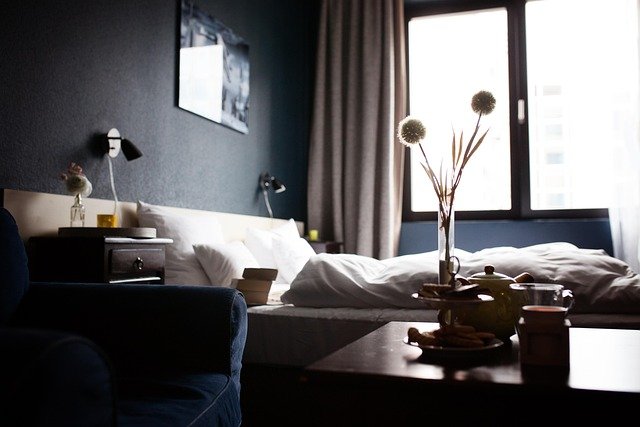Acoustic Textiles: Harmonizing Sound and Style in Home Decor
Imagine walking into a room where the very fabric of your surroundings doesn't just please the eye, but also soothes the ear. Welcome to the world of acoustic textiles, where innovative design meets cutting-edge sound technology to create harmonious living spaces. This revolutionary approach to interior design is transforming how we think about the interplay between aesthetics and acoustics in our homes.

The science behind acoustic textiles lies in their structure. These fabrics are typically made from materials with high sound absorption coefficients, such as polyester fibers, wool, or recycled materials. The fibers are arranged in a way that creates tiny air pockets, which trap sound waves and convert them into heat energy. This process effectively reduces echo and reverberation, creating a more pleasant acoustic environment.
Weaving Comfort: The Benefits of Acoustic Textiles in Home Design
Incorporating acoustic textiles into home design offers a myriad of benefits beyond mere noise reduction. For urban dwellers battling the constant hum of city life, these fabrics can create a sanctuary of calm within the home. In open-plan living spaces, acoustic textiles can help define separate areas acoustically without the need for physical barriers, maintaining a sense of openness while reducing sound travel.
Moreover, acoustic textiles contribute to improved concentration and productivity in home offices, enhanced relaxation in bedrooms, and better communication in living areas. They’re particularly beneficial in homes with hard surfaces like wood floors, large windows, or high ceilings, which tend to amplify sound reflections.
From Whisper to Wow: Aesthetic Versatility of Acoustic Fabrics
Gone are the days when sound-absorbing materials were limited to unsightly foam panels. Today’s acoustic textiles come in a stunning array of colors, patterns, and textures, allowing them to seamlessly integrate into any design scheme. From sleek, minimalist designs to bold, artistic statements, these fabrics offer endless possibilities for creative expression.
Designers are now creating acoustic textiles that double as art pieces. Imagine a tapestry that not only serves as a striking focal point but also improves the room’s acoustics. Some manufacturers are even developing three-dimensional acoustic textiles that add depth and texture to walls while providing superior sound absorption.
Orchestrating Spaces: Practical Applications of Acoustic Textiles
Incorporating acoustic textiles into home design can be as subtle or as dramatic as desired. One popular application is the use of acoustic curtains. These heavy, sound-absorbing drapes not only control light but also significantly reduce noise from outside, creating a more peaceful indoor environment.
Acoustic wall panels are another effective solution, especially in rooms with challenging acoustics. These can be customized to match or complement existing decor, appearing as elegant wall coverings while secretly working to improve sound quality. For a more discreet approach, acoustic textiles can be used to upholster furniture, turning everyday items like sofas and chairs into sound-absorbing elements.
The Future Sounds Good: Innovations in Acoustic Textile Technology
As technology advances, so does the potential of acoustic textiles. Researchers are exploring smart acoustic fabrics that can adapt to changing sound environments. Imagine curtains that automatically adjust their sound-absorbing properties based on the noise level in the room.
Another exciting development is the integration of acoustic textiles with other smart home technologies. For instance, fabrics embedded with conductive threads could potentially control lighting or temperature while also managing acoustics. This convergence of functionality could lead to truly responsive living spaces that adapt to our needs in real-time.
Sustainability in Sound: Eco-Friendly Acoustic Solutions
The push towards sustainability in interior design has not bypassed acoustic textiles. Many manufacturers are now producing these fabrics using recycled materials or sustainable fibers. Some are even developing biodegradable acoustic textiles, ensuring that these products don’t contribute to environmental waste at the end of their lifecycle.
Moreover, the energy-saving potential of acoustic textiles is gaining recognition. By improving indoor acoustics, these fabrics can reduce the need for electronic sound masking systems, thereby lowering energy consumption in buildings.
Hearing is Believing: Selecting and Maintaining Acoustic Textiles
When choosing acoustic textiles for your home, consider factors such as the Noise Reduction Coefficient (NRC) of the fabric, which indicates its sound-absorbing efficiency. The higher the NRC, the more effective the fabric is at absorbing sound. Also, think about the specific acoustic challenges in your space – are you dealing with external noise, echo, or both?
Maintenance of acoustic textiles is generally straightforward. Most can be vacuumed regularly to remove dust, while some are even machine washable. However, it’s essential to follow the manufacturer’s care instructions to maintain the fabric’s acoustic properties and appearance over time.
Composing Your Acoustic Haven: Tips for Implementation
Integrating acoustic textiles into your home doesn’t require a complete overhaul of your existing decor. Start small by replacing regular curtains with acoustic ones or adding a few decorative acoustic panels to problematic areas. As you become more comfortable with the concept, you can explore more comprehensive solutions.
Remember that acoustic textiles work best as part of a holistic approach to sound management. Combine them with other sound-absorbing elements like rugs, plants, and strategically placed furniture for optimal results. The goal is to create a balanced acoustic environment that enhances your living experience without compromising on style.
In conclusion, acoustic textiles represent a harmonious blend of form and function in interior design. By addressing the often-overlooked aspect of sound in our living spaces, these innovative fabrics are helping to create homes that not only look beautiful but also sound and feel more comfortable. As we continue to seek ways to optimize our living environments, acoustic textiles stand out as a solution that truly resonates with modern lifestyle needs.





